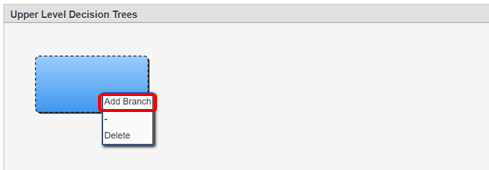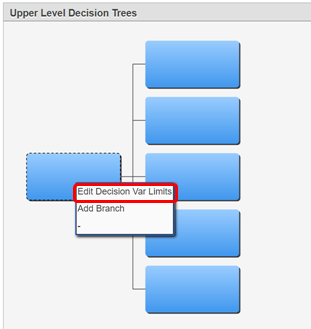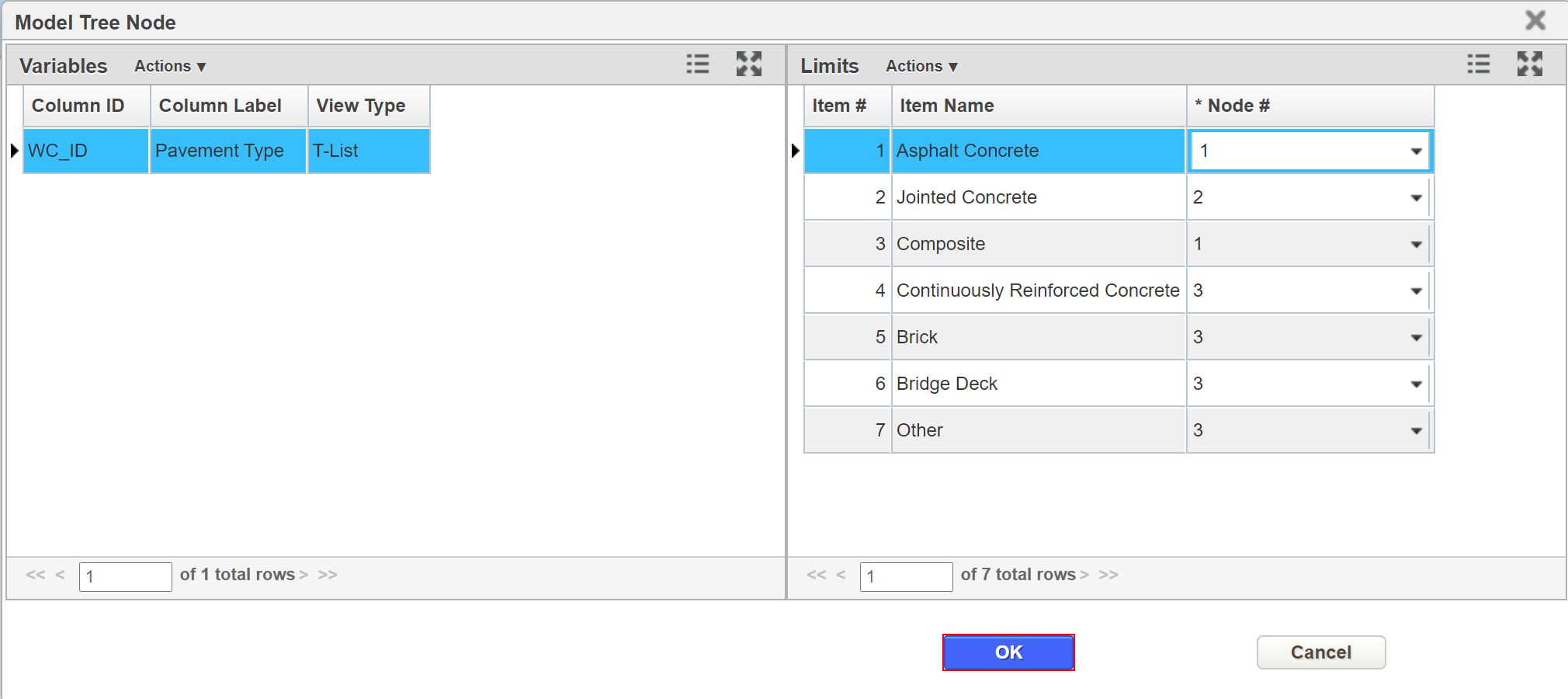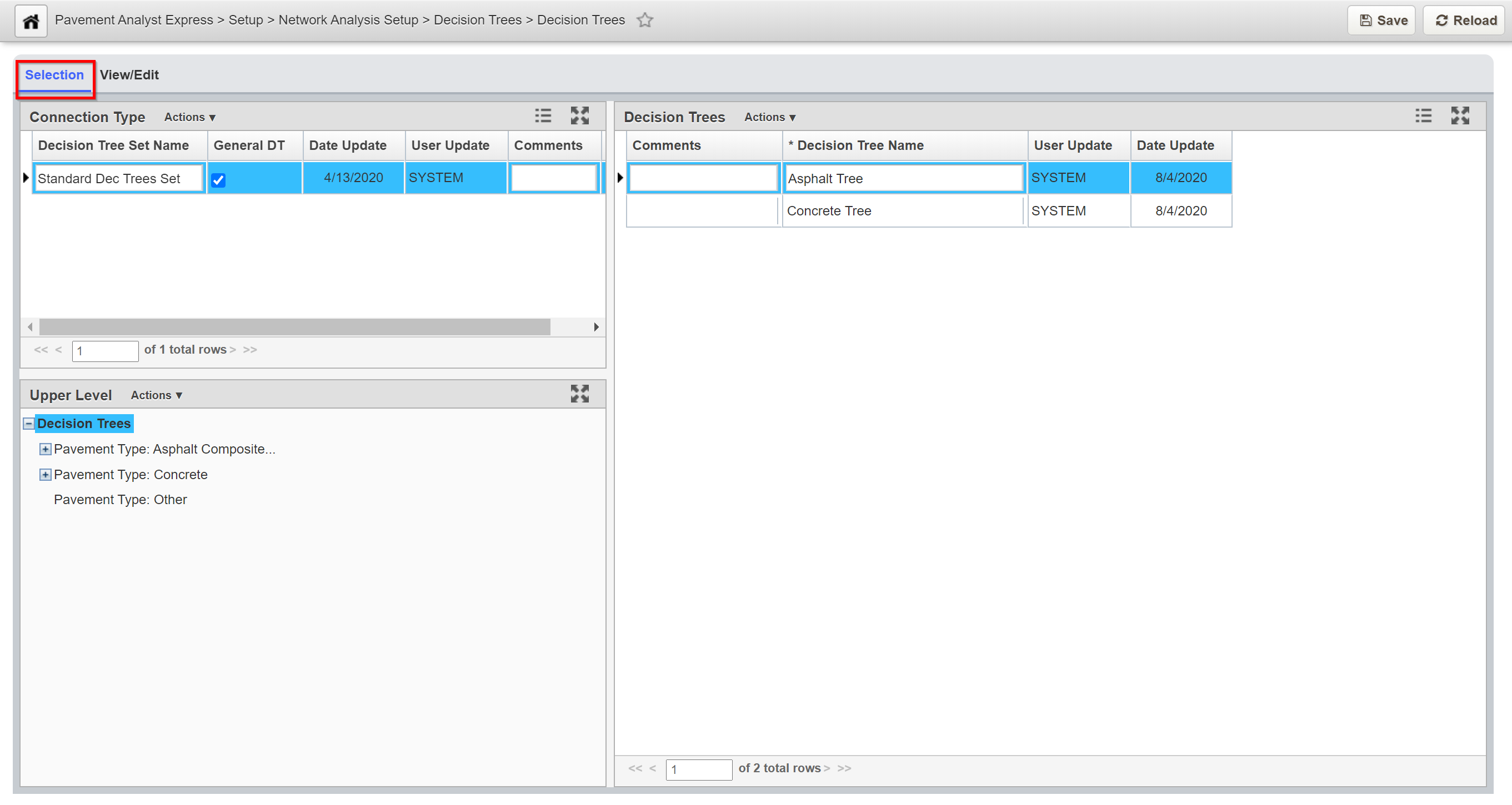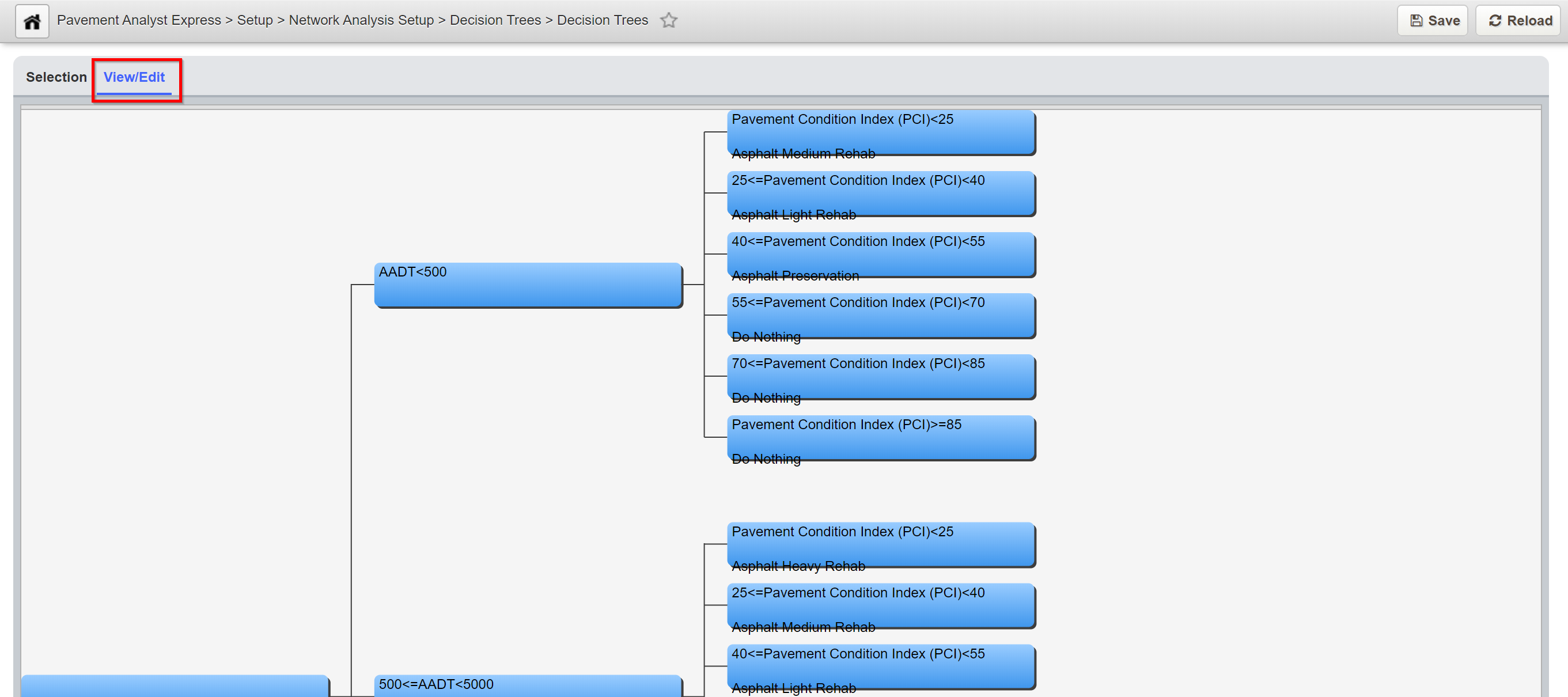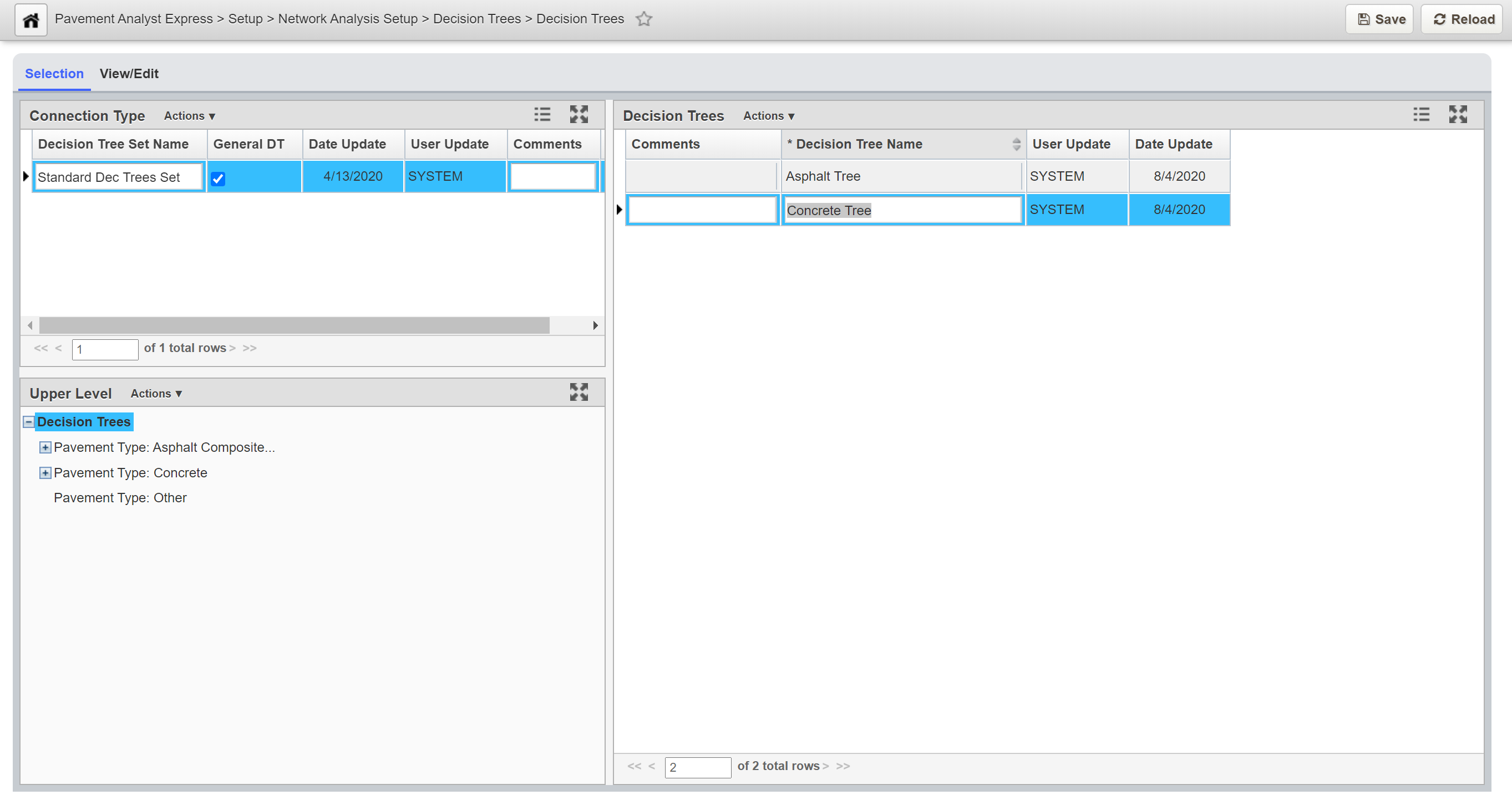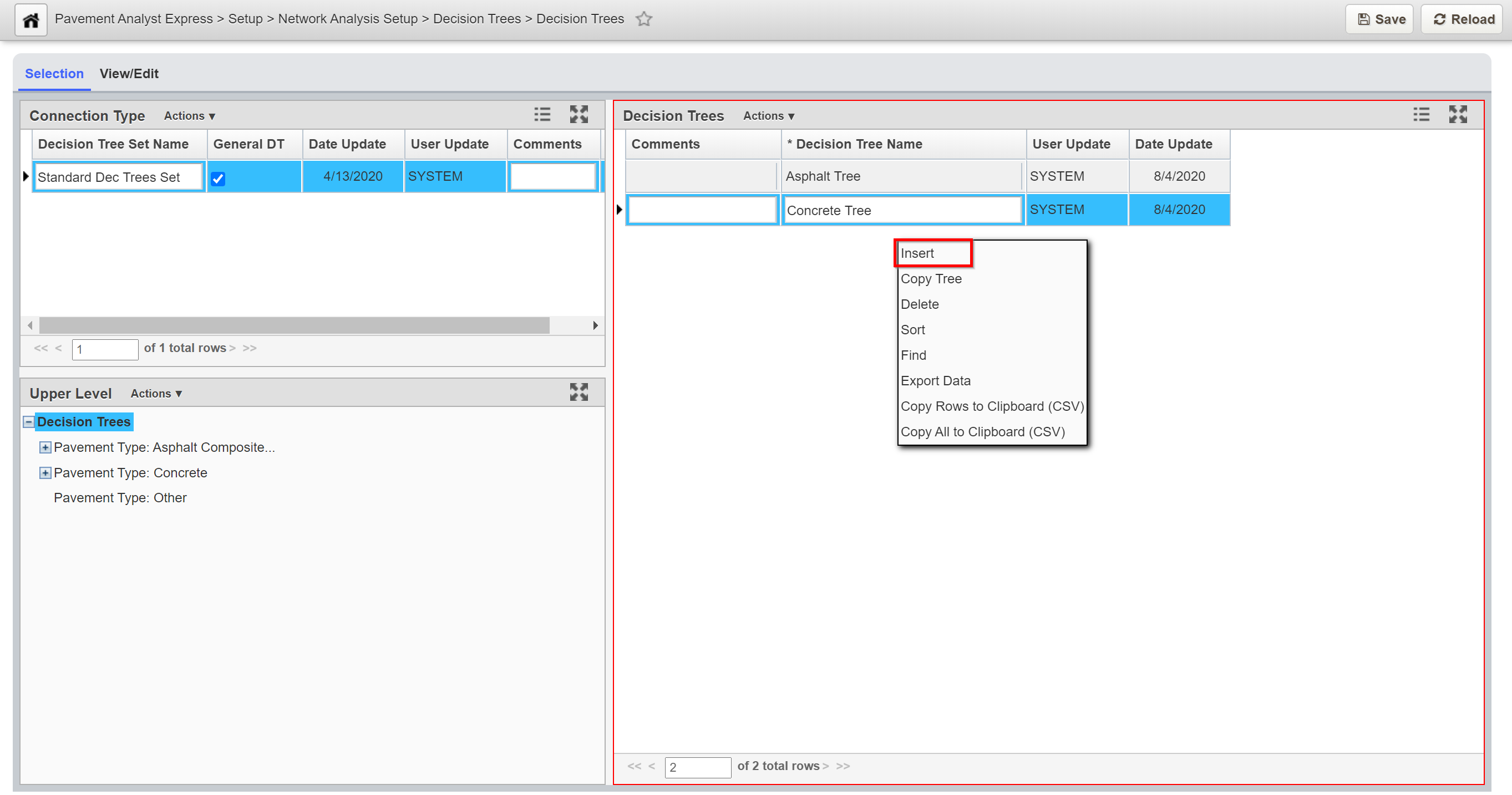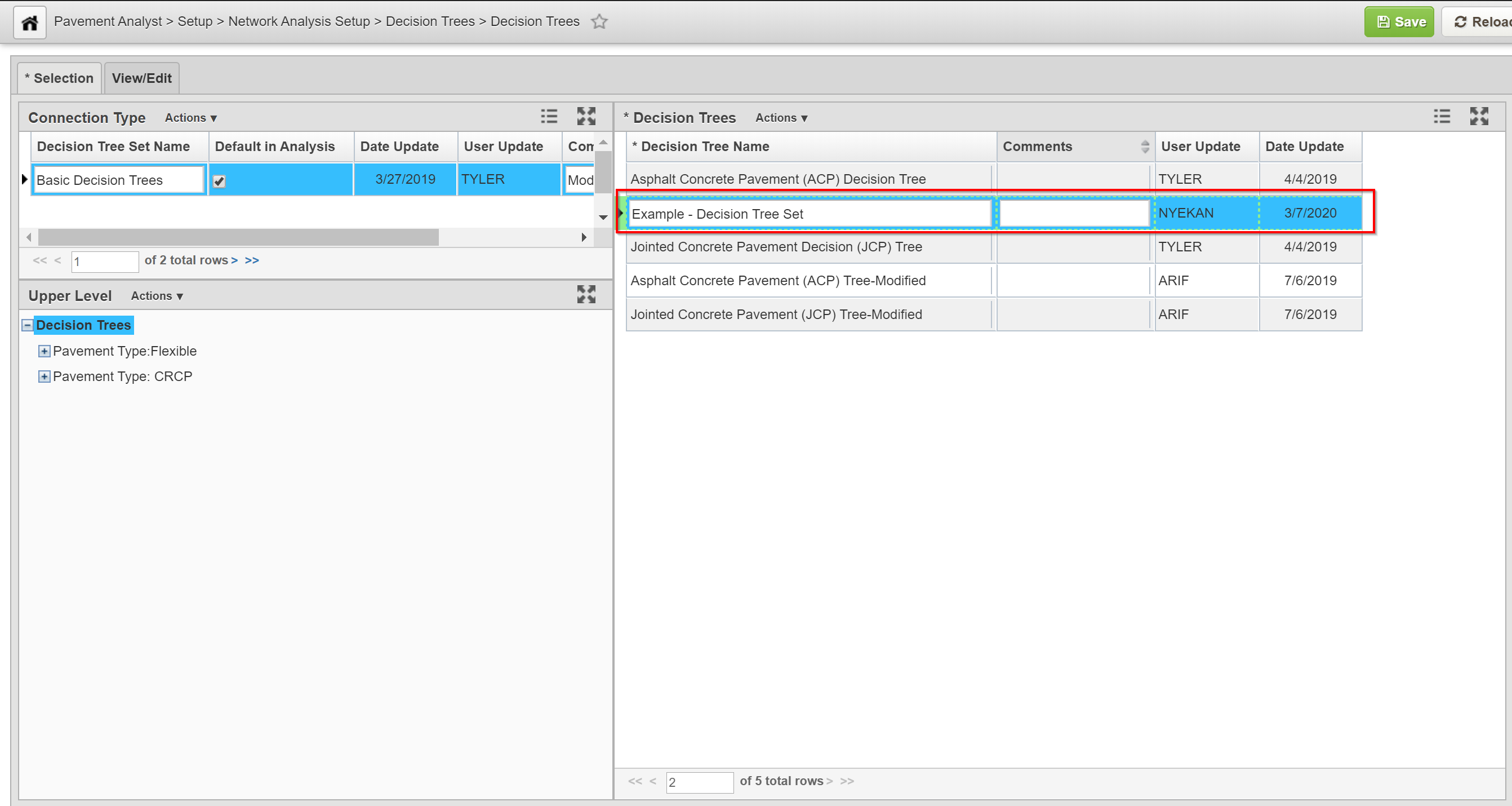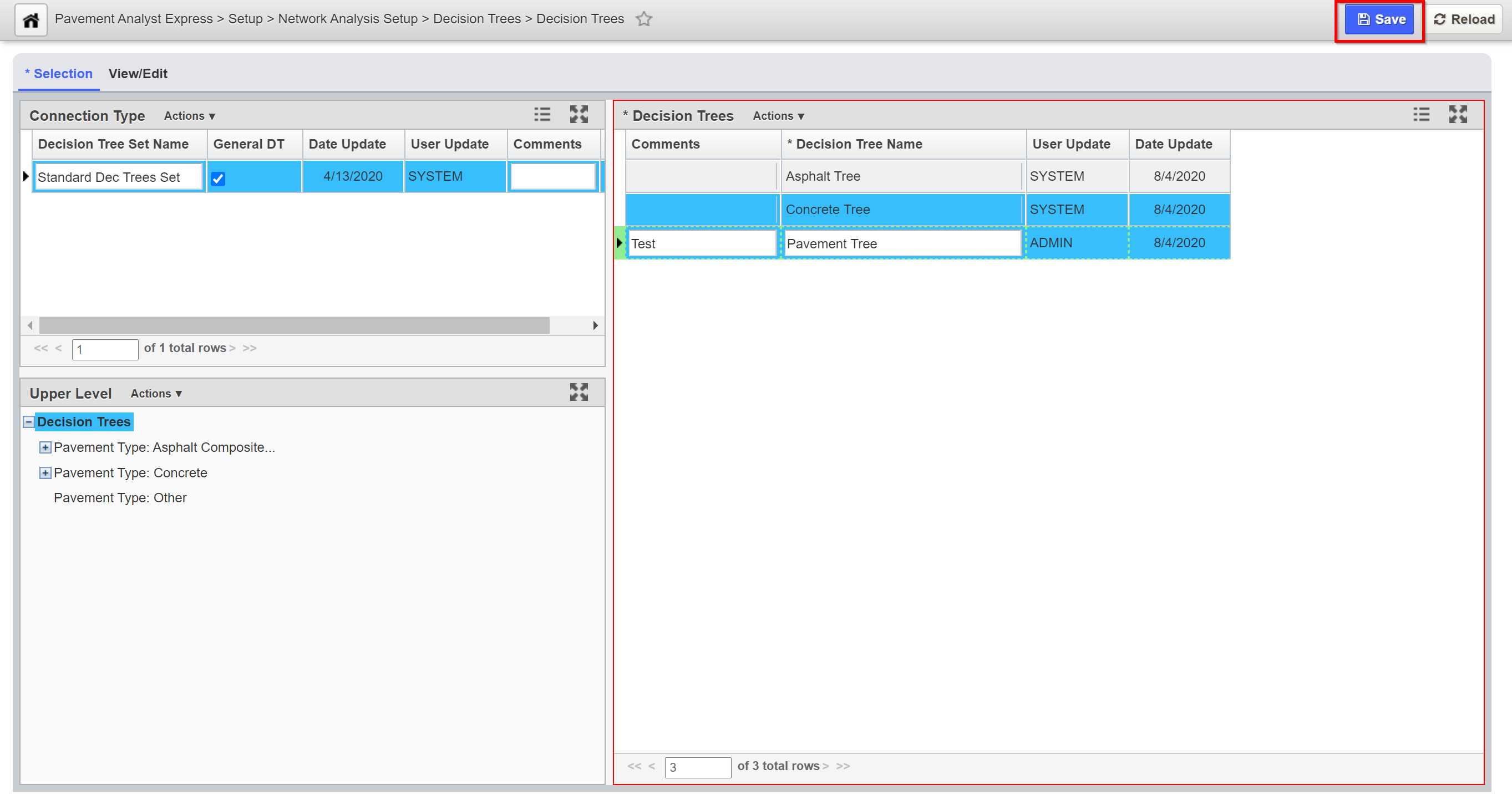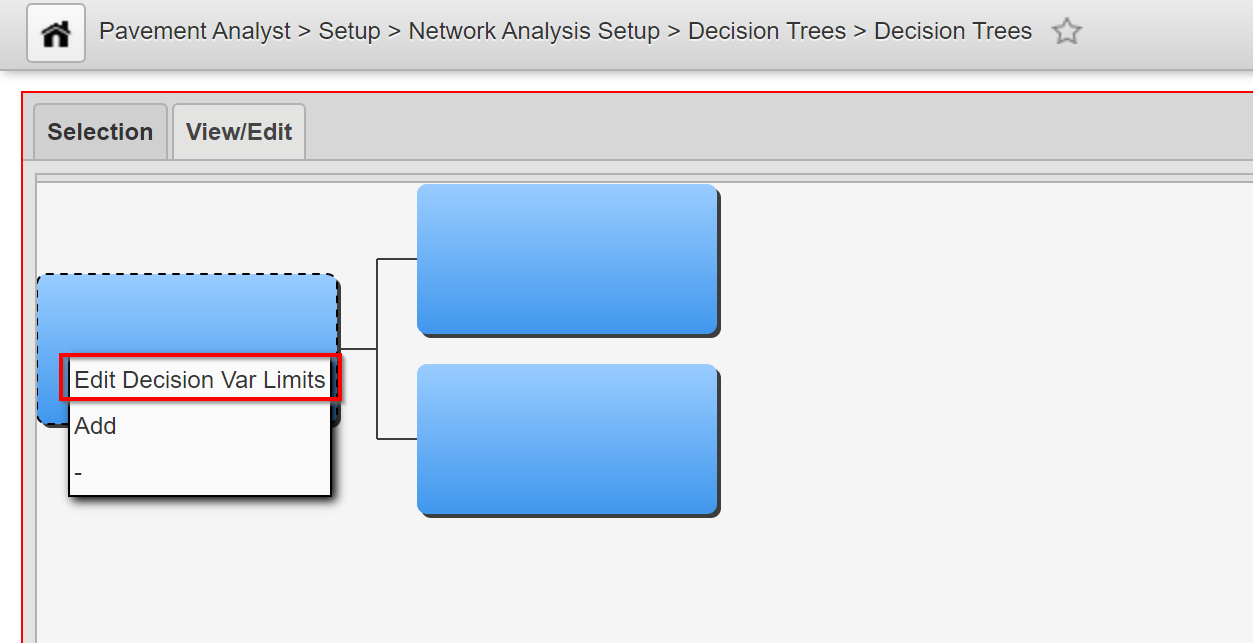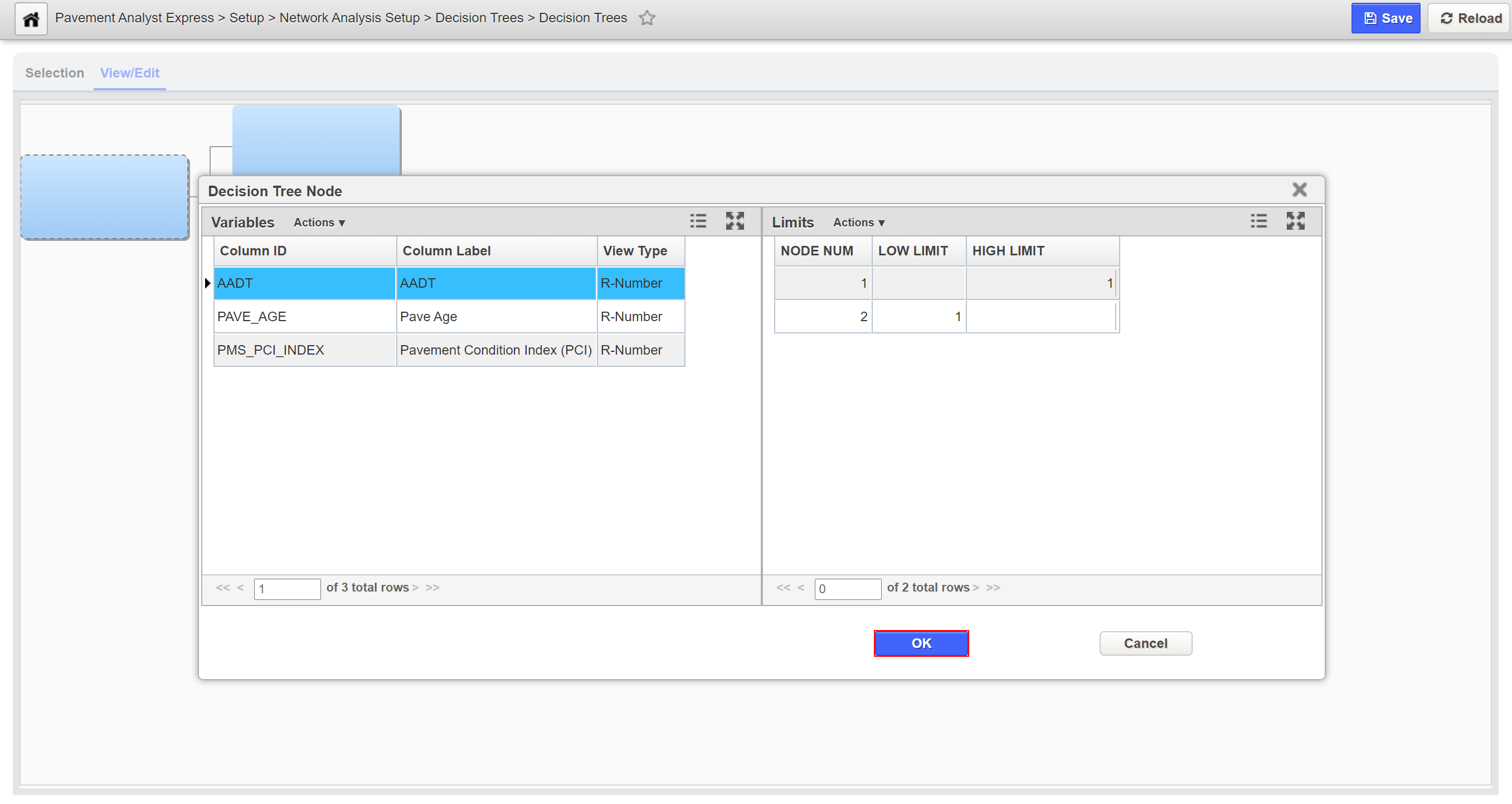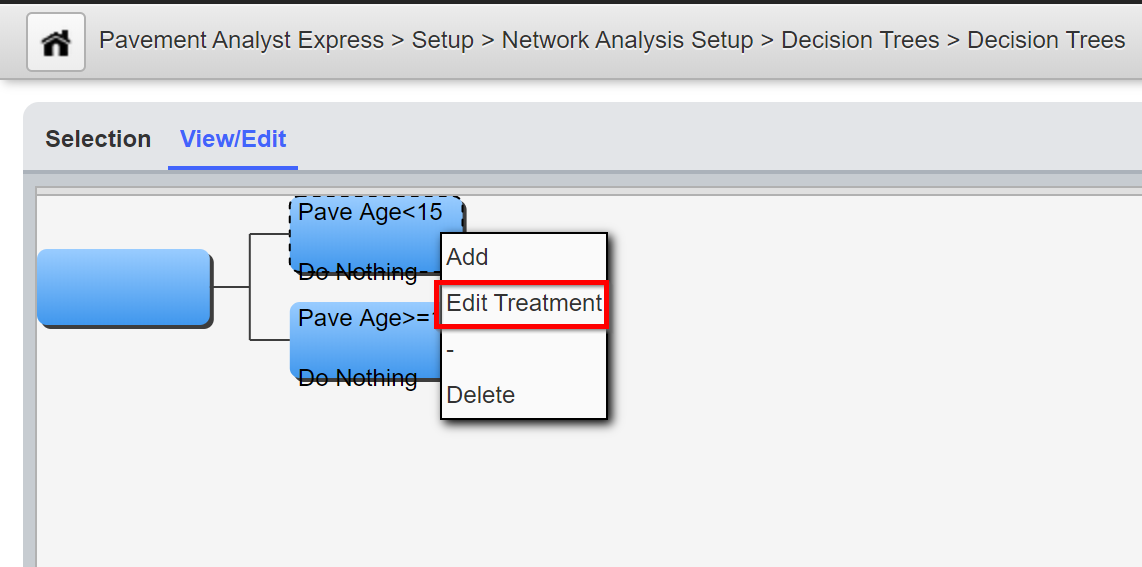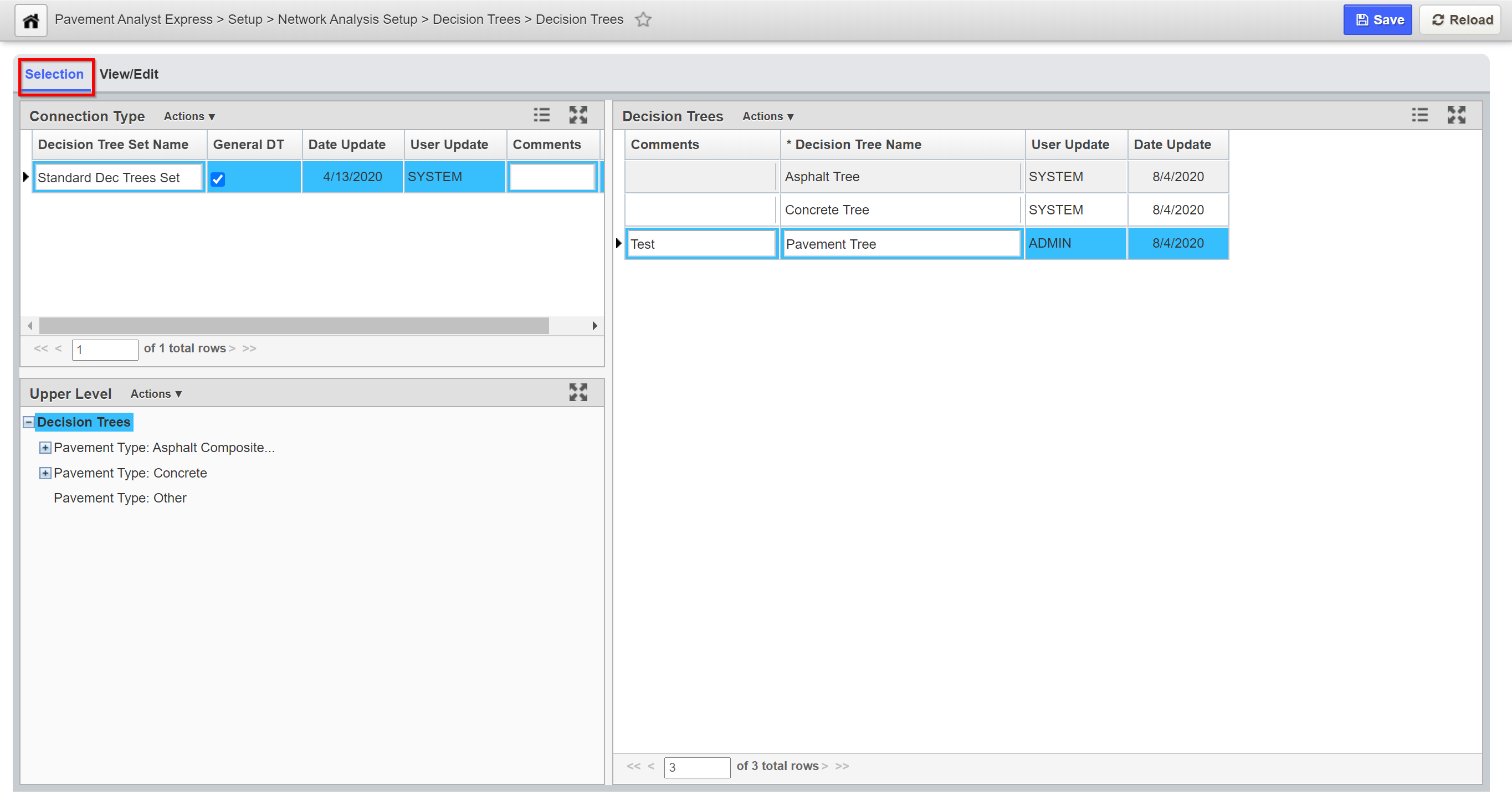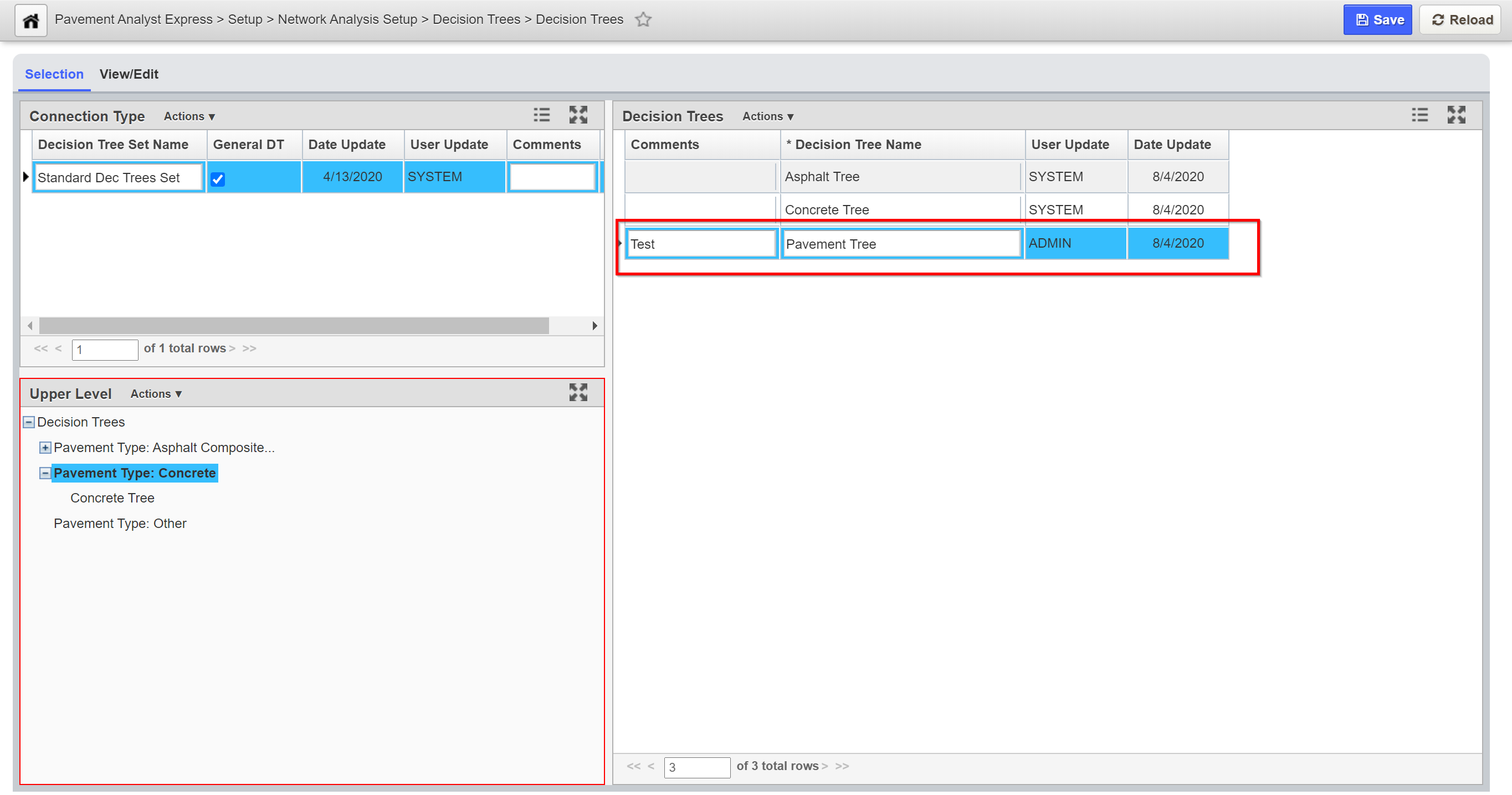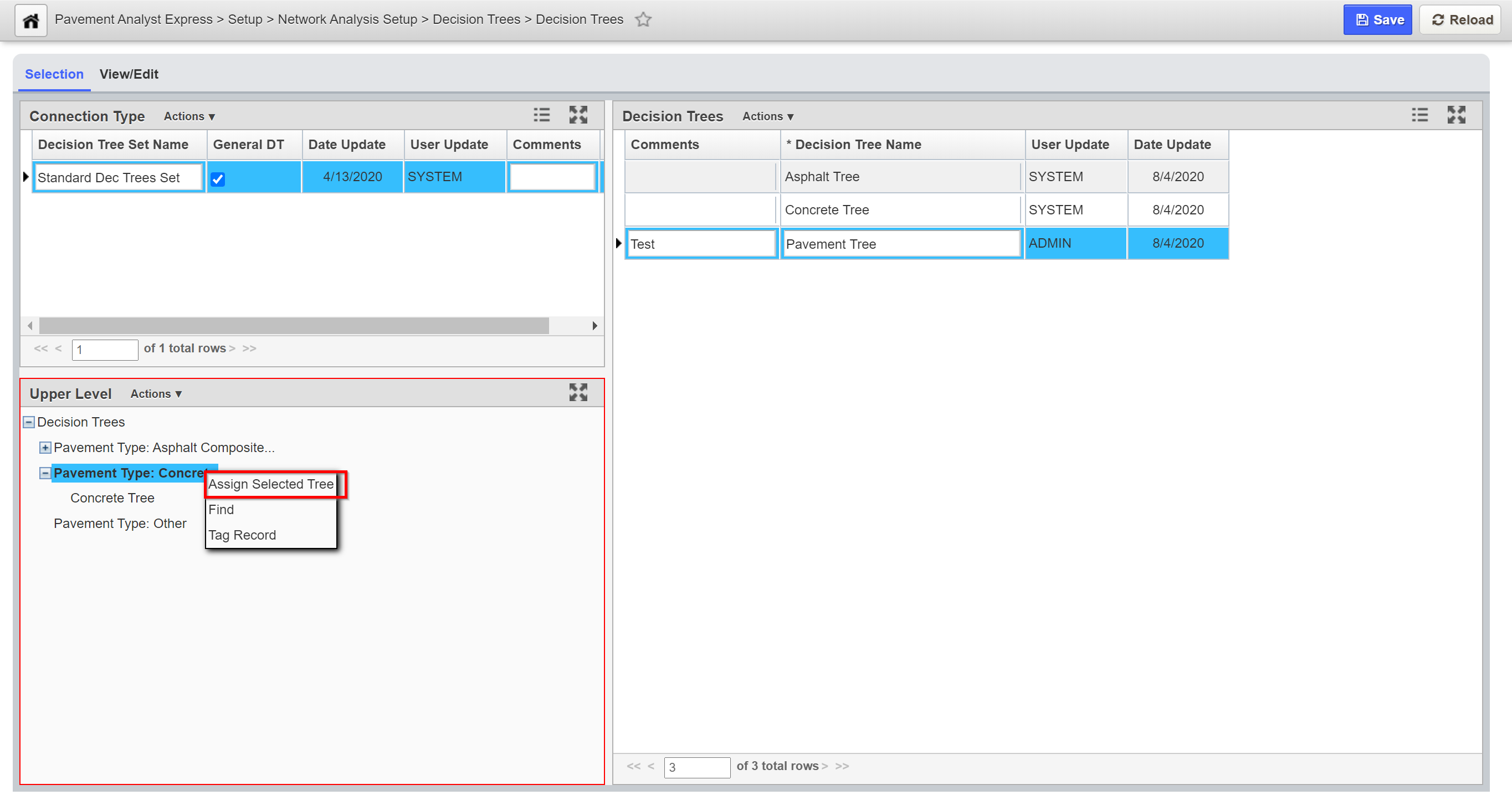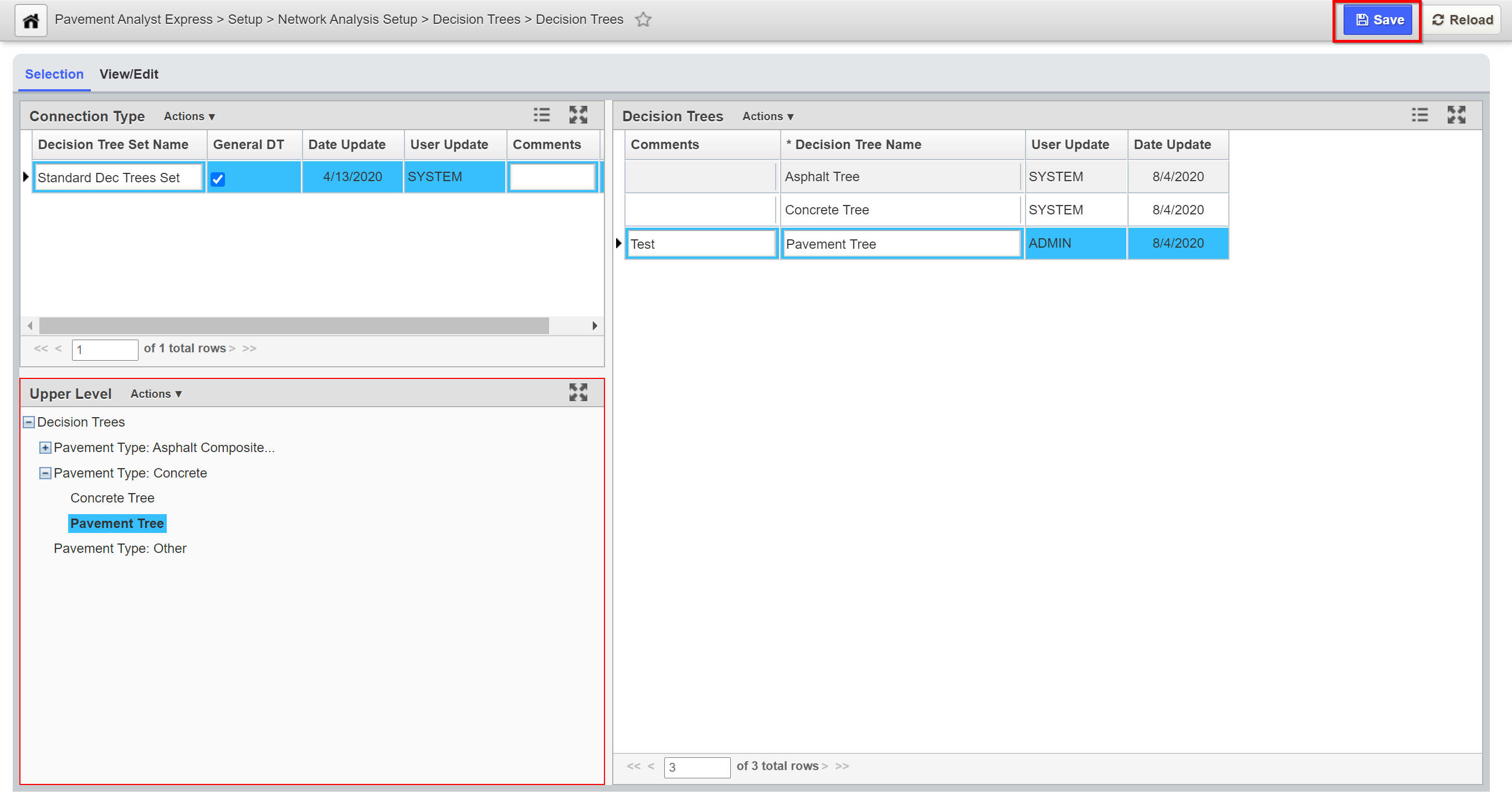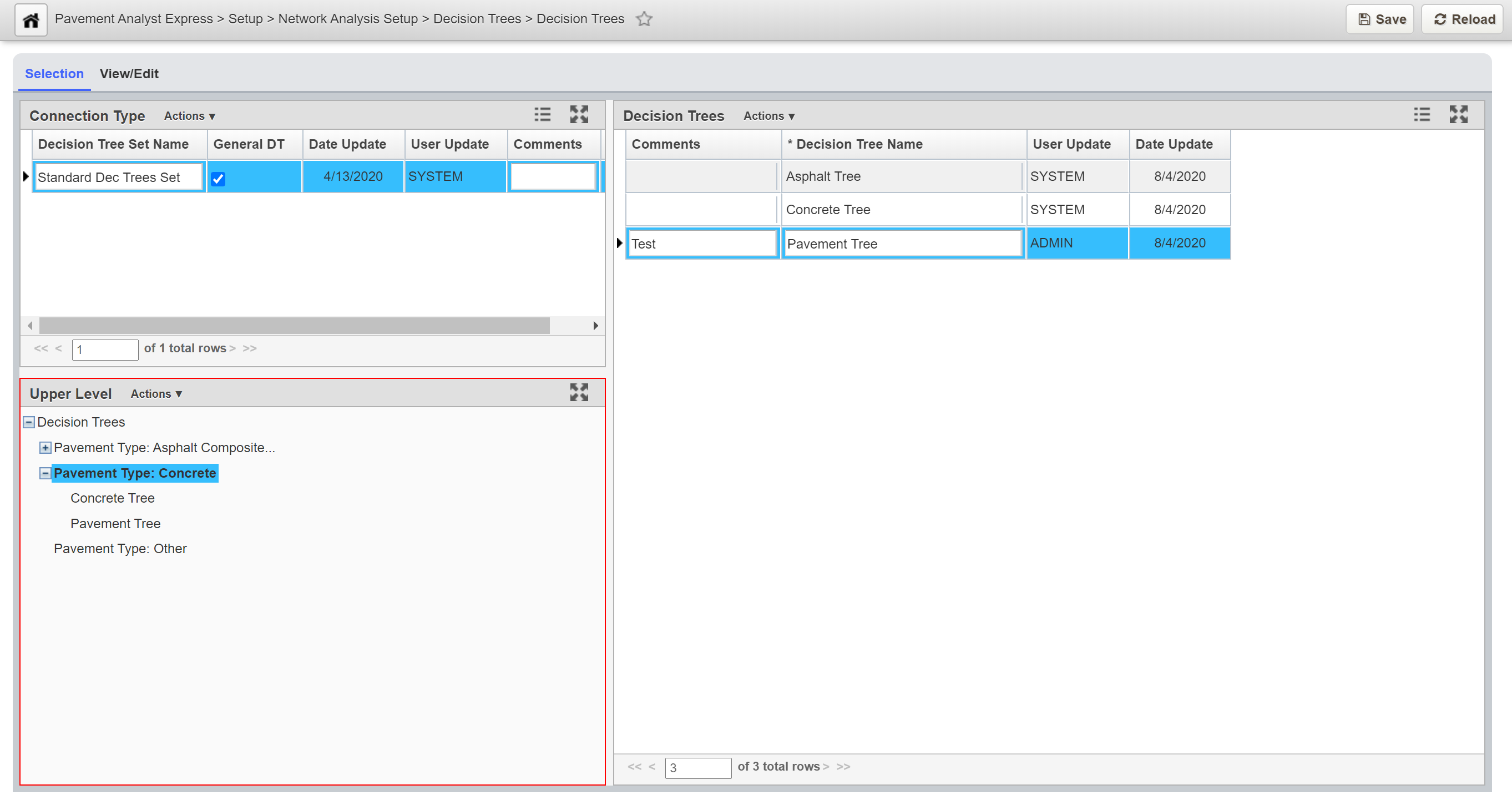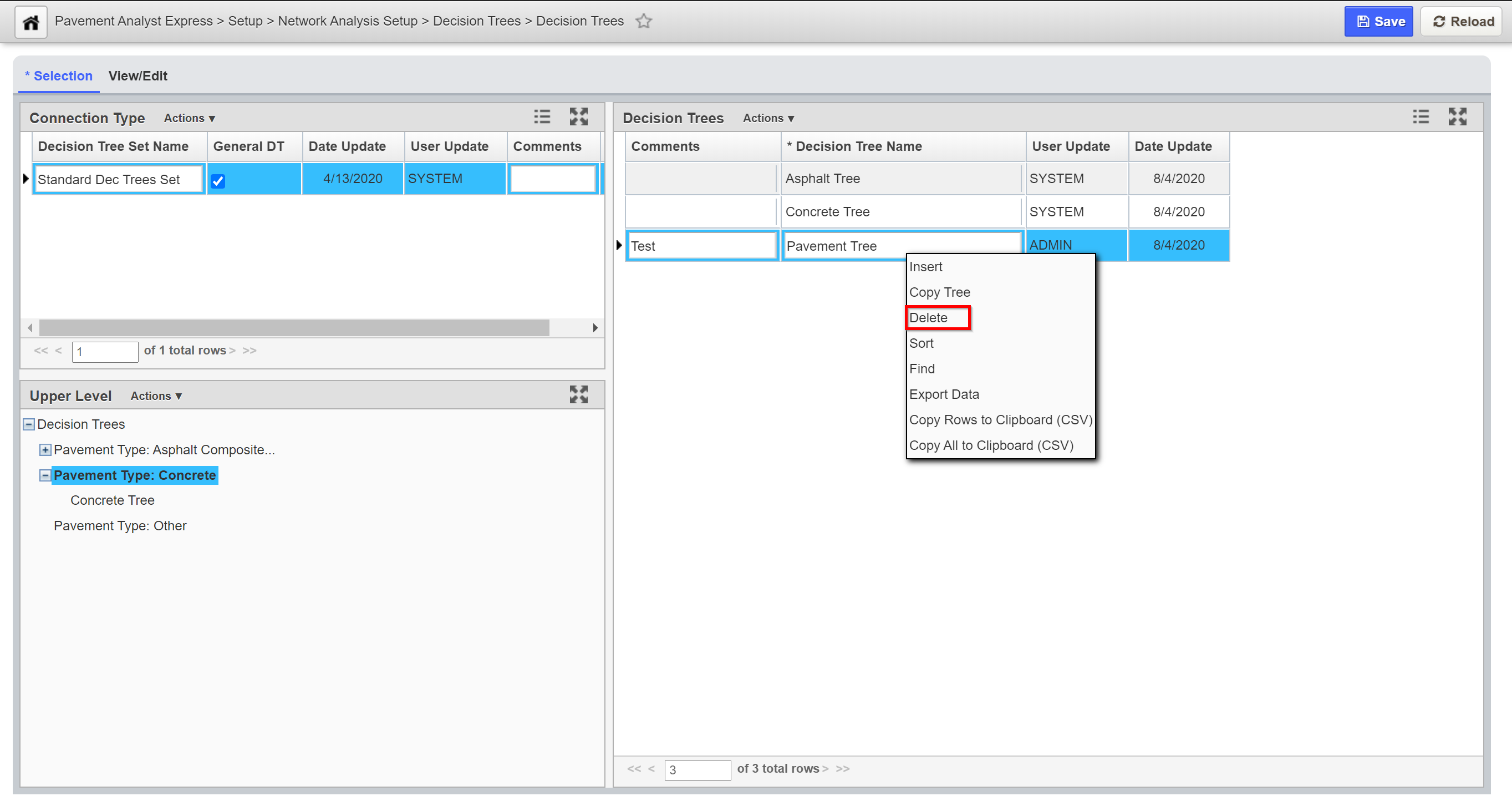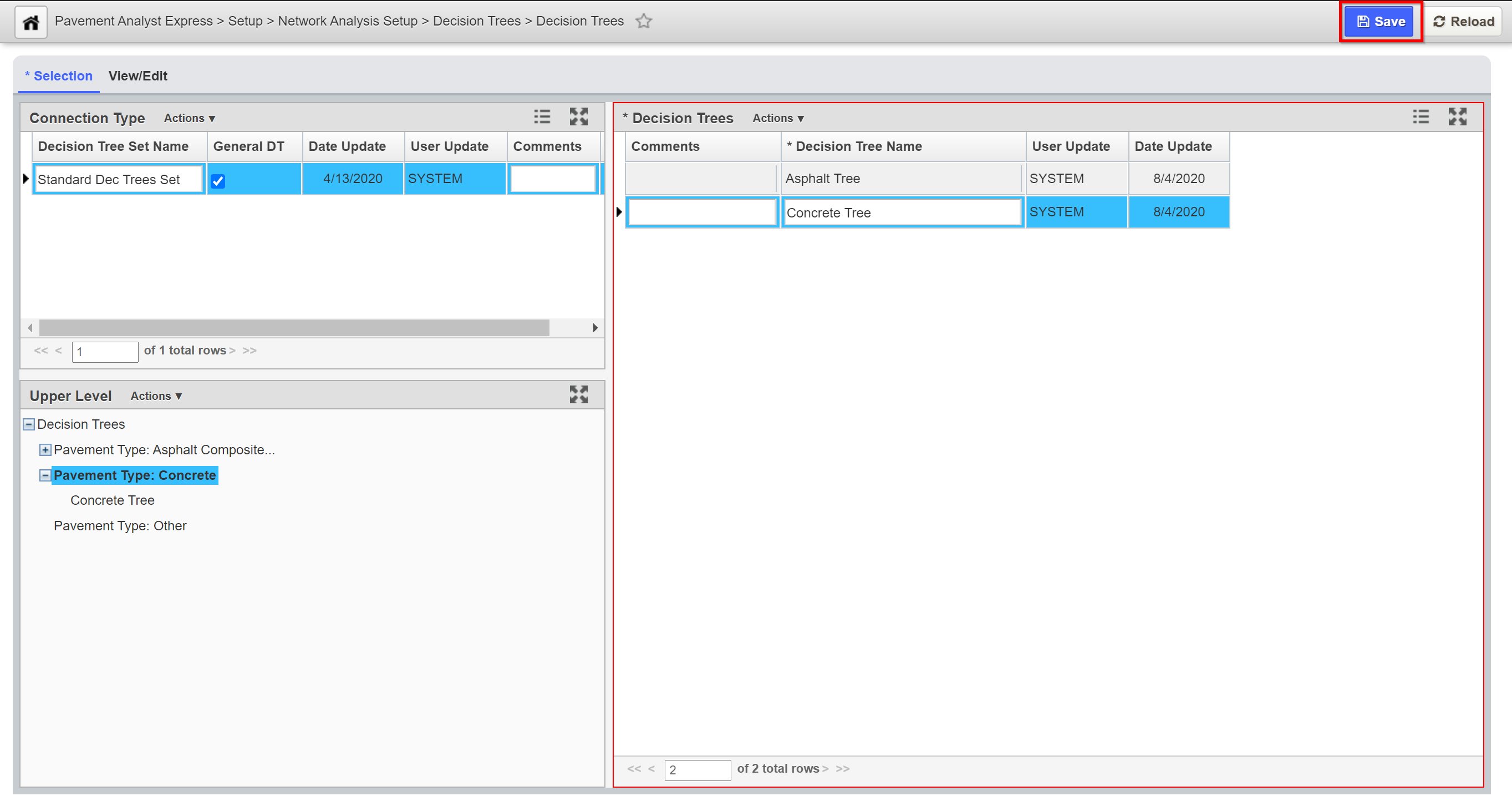Decision Tree is a series of logics and rules that determine needs for pavement. Typically, Decision Tree is composed from various engineering decisions and reflects the agency’s overall pavement maintenance strategy. A full Decision Tree set is the combination of an Upper-Level Decision Tree and one or more Lower-Level Decision Trees. These Decision Trees are then grouped into a Decision Tree Set.
Upper Decision Tree
Click Here for Training Exercise
Upper-Level Decision Tree defines the upper portion of the decision tree. The system allows only one Upper-Level Decision Tree and it will be applied to all Decision Tree sets. Typically, Upper-Level Decision Tree uses high-level variables in the logic, such as Pavement Type, Traffic Level or Roadway Category. Then, the lower level decision trees are assigned to the end nodes defined in the upper level decision tree.
The objective of this lesson is for the participant to understand how to view and update the Upper Level Decision Tree, as well as configure the Lower-Level Decision Tree. At the end of this lesson, the user should be able to review and/or update the Upper Level Decision Tree and configure the Lower-Level Decision Tree (if applicable). |
|---|
In this example, we review and update the Upper Level Decision Tree by performing the following steps:
- Open the Upper Level Decision Tree window: Pavement Express > Setup > Network Analysis Setup > Decision Trees > Upper Level Decision Tree
Note: From here you can make changes on the Upper-Level Decision Trees which has a Pavement Type variable. You can either use it as is, or expand from here, or delete all the nodes and configure different variables.
To edit the tree, use the Right-click function to delete existing branches and/or to add branches. The Add command adds a node or nodes as children beneath the node you right clicked. After selecting this command, the system displays a dialog box, so you may enter the number of nodes needed. Then click OK.
2. Right-click the parent node will open a menu. Select Edit Decision Var Limits (this command is only available for nodes that have children).
3. The Model Tree Node pop-up window will open. The Variables (left) pane shows the variables and the Limits (right) pane shows the values that determine which tree branch will be selected. Additionally, in the Limits (right) pane, in the Node# column you set the branch corresponding on which value.
A. Select a variable in the Variables pane
B. The Limits pane will now show the list of options for the selected variable
C. Complete the node number column for each branch of the decision tree to assign each option to a branch
Additional Details:
Once the Upper-Level Decision Tree has been configured, all the Lower-Level Decision Tree and Decision Tree Sets are configured in the Decision Tree window, located at Pavement Express > Setup > Network Analysis Setup > Decision Trees > Decision Trees menu. This window contains two tabs: The Selection tab and the View/Edit tab.
The Selection tab contains the following panes: Decision Tree Sets, Upper Level, and Decision Trees.
The View/Edit tab - For the Lower-Level decision tree selected in the Decision Trees pane of the Selection tab, the View/Edit tab shows the nodes of the lower-level decision tree. Use the View/Edit tab to create and maintain lower-level decision trees by editing their structure, decision thresholds, and treatment outcomes. For parent nodes, the decision variable is shown. For child nodes, the treatment is displayed. The decision tree flows from left to right, and the nodes are numbered from the top to the bottom.
When this tab is displayed, the system only displays a portion of the decision tree. You can view other parts of the decision tree by holding down the mouse key and then dragging the decision tree as desired. You can also change the magnification by using the wheel on the mouse.
Create a New Decision Tree
Configuration of a Decision Tree Set starts with creating a new one. Decision trees are grouped in sets, which are shown in the Decision Tree Sets pane.
The objective of this lesson is for the participant to understand how to create a new Decision Tree. At the end of this lesson, the user should know how to build a new Decision Tree. |
|---|
In this example, we create a new Decision set by performing the following steps:
- Open the Decision Trees window.
2. In the Decision Tree (right) pane, right-click and select Insert. A new record is added to the pane.
3. In the Decision Tree Name column of the new record, enter a name for the set. (The name you enter here will appear in the drop-down list in the Optimization Analysis window.)
4. Click the Save button to save the new information.
Create a New Lower-Level Decision Tree
After the Decision Tree Set have been created, the next step is to create a new Lower-Level decision tree.
The objective of this lesson is for the participant to understand how to create a new Lower-Level Decision Tree. At the end of this lesson, the user should know how to build a new Lower-Level Decision Tree. |
|---|
In this example, we create a new Lower-Level Decision tree (from the Decision Tree created in previous exercise) by performing the following steps
- Open the Decision Trees window.
2. In the Decision Trees pane of the Selection tab, highlight the Decision Tree that was created in previous exercise.
3. Click on the View/Edit tab. The application shows a single node that is the start of the decision tree.
4. Right-click the node and select Add. The system displays a dialog box so you can enter the number of nodes required.
5. Using the hierarchy diagram developed, enter the number of nodes needed below the node in the dialog box and select OK. The system adds the entered number of nodes to the decision tree.
6. Repeat steps 4 and 5 to create the hierarchy to match the decision tree diagram.
Note: Once the decision tree is created, the next step is to add the decision variables and values that govern what branches are selected.
1 Right-click a parent node and select Edit Decision Var Limits. The system displays a dialog box so you can select the desired decision variable.
2. In the left pane of the dialog box, select the desired decision variable. The system responds by configuring the right pane for entry of the values that cause each child node to be selected.
3. Configure the right pane of the dialog box to appropriately select each child node.
4. Select OK to close the dialog box.
5. Repeat steps 1 through 4 for the remaining parent nodes in the decision tree.
Note: Now that the decision variables and values are set, the final task is to assign treatments to the termination points of each branch in the decision tree.
To assign the first treatment, use the following steps:
- Right-click the first termination node and select Edit Treatment. The system responds by displaying a dialog box, so you can select the desired treatment.
2. In the dialog box, click the down arrow to display the list of treatments and select the desired treatment.
3. Select OK to close the dialog box. The selected treatment is shown in the termination node (alternate treatments are shown by hovering over the node).
4. Repeat steps 1 through 3 for the remaining termination nodes of the decision tree.
5. Select on the Selection tab again.
6. Click the Save button to save the new information.
Note: A list of all available treatments for optimization analysis and their properties are displayed in the Treatments window.
Assign, Dis-Assign, or Delete a Decision Tree
The objective of this lesson is for the participant to understand how to Assign, Un-Assign or Delete a Decision Tree. At the end of this lesson, the user should know how to Assign, Disassociate, or Delete a Decision Tree. |
|---|
Connect a Lower-Level Decision Tree
In this example, we connect a Lower-Level Decision Tree to an Upper-Level Decision Tree node by performing the following steps:
- Open the Decision Trees window.
2. In the Decision Tree Sets pane, select the appropriate decision tree set by locating the record for the desired set and selecting the record to select it. The system responds by highlighting the record to show that it is selected and also refreshes the Upper Level pane to show the lower-level decision tree assignments for the selected decision tree set.
3. In the table of the Decision Trees pane under the Selection tab, click the record showing the lower-level decision tree to be assigned. The system highlights the record to show that it is selected.
4. In the Upper Level pane on the lower left, find the child node of the upper-level decision tree to which you want to assign the selected lower-level decision tree.
5. Right-click the child node found in the previous step and select Assign Selected Tree. The system refreshes the hierarchy shown in the Upper Level pane to show the lower-level decision tree attached to the upper-level decision tree.
6. Click the Save button to save the new information.
Note:
A Lower-level Decision tree must first be remove from the Upper Level tree to be deleted. To disassociate a Lower-level Decision Tree in the Upper Level pane of the Selection tab, find the node that corresponds to the lower-level decision tree that will be disassociated from the upper-level decision tree and Right-click on it. Select Remove Tree. Then click the Save button to save the new information.
Delete a Lower-Level Decision Tree
In this example, we delete a lower-level decision tree by performing the following steps:
- Open the Decision Trees window.
2. Right-click on the Upper-level Decision tree to be removed and select Remove Tree.
3. Click the Save button to save the new information.
4. In the table of the Decision Trees pane under the Selection tab, right-click the lower-level decision tree to be deleted and select Delete. The application checks whether the decision tree is assigned. If it is not assigned, the tree is deleted.
5. If the decision tree is assigned, the application displays a message that says, "This sub-tree is still assigned, do you still want to delete?" Click Yes if you want to delete it; otherwise, click No.
6. Click the Save button to save the new information.
Modify a Lower-Level Decision Tree
In this example, we modify a lower-level decision tree by peforming the following procedures:
- To change the name of a decision tree in the table of the Selection tab, highlight the existing name and then type the new name.
- To change the treatment assigned to a termination node, right-click the node and select the appropriate command for which treatment you wish to change.
- To change the values that determine which branch is followed, display the View/Edit tab. Then right-click the parent node and click Edit Decision Var Limits. In the dialog box that displays, re-configure the right pane with new values to determine what branches are followed depending on the value of the decision variable.
- To change the decision variable that determines which branch is followed, you can only use a decision variable that has not been used at a different level of the decision tree. This may mean that you will have to alter the decision variables for more than one node. To change the decision variable, use the Edit Decision Var Limits command to select the decision variable and the values that determine what branch is followed.
- If you want to remove a node from the decision tree, only child nodes can be deleted. Furthermore, if a parent only has two child nodes and you delete one of them, the system will automatically delete the other as well. To delete a node, right-click the child node and select Delete.
